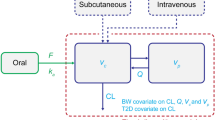Abstract
Purpose. The goal of this study was to establish and validate an in vitro-in vivo correlation (IVIVC) for two sustained-release formulations (i.e., a matrix tablet and a RingCap banded matrix tablet) containing 750 mg of acetaminophen.
Methods. The in vitro dissolution and in vivo disposition of these formulations were examined by using a USP type III dissolution apparatus and a single-dose, three-way, crossover study that included an immediate-release acetaminophen dosage form, respectively. An IVIVC was established by using the mean fraction dissolved (FD) and mean fraction absorbed (FA) and used to simulate the plasma concentation-time profile of acetaminophen after administration of the matrix tablet (i.e., internal validation) and RingCap banded matrix tablet (i.e., external validation).
Results. A statistically significant relationship (r 2 = 0.997, P < 0.001) existed between the FD and FA for matrix tablets and was best described by the equation (FA) = 0.984 × (FD) + 0.0133. The percent predictions errors in CMAX and AUCL were <10% when predicting the plasma concentration-time profiles for the two formulations, validating the internal and external predictability of the IVIVC.
Conclusions. The data (i) show that in vitro dissolution data are a good predictor of in vivo fraction absorbed for acetaminophen, (ii) support the general use of in vitro dissolution data for readily soluble and readily absorbed drugs, (iii) suggest that acetaminophen may serve as a model drug for evaluating novel sustained-release delivery systems, and (iv) provide a tangible example of the limitations of current methods for predicting and validating IVIVC.
Similar content being viewed by others
REFERENCES
M. C. Meyer, A. B. Straughn, R. M. Mhatre, V. P. Shah, R. L. Williams, and L. J. Lesko. The relative bioavailability and in vitro-in vivo correlations for four marketed carbamazepine tablets. Pharm. Res. 15:1787-1791 (1998).
K. Yu, M. Gebert, S. A. Altaf, D. Wong, and D. R. Friend. Optimization of sustained-release diltiazem formulations in man by use of an in-vitro/in-vivo correlation. J. Pharm. Pharmacol. 50:845-850 (1998).
N. D. Eddington, P. Marroum, R. Uppoor, A. Hussain, and L. Augsburger. Development and internal validation of an in vitro-in vivo correlation for a hydrophilic metoprolol tartrate extended release tablet formulation. Pharm. Res. 15:466-473 (1998).
D. Young, J. G. Devane, and J. Butler. In Vitro-In Vivo Correlations. Advances in Experimental Medicine and Biology, Vol. 423, Plenum Press, New York, 1997.
G. L. Amidon, J. R. Robinson, and R. L. Williams, Scientific Foundations for Regulating Drug Product Quality, AAPS Press, Alexandria, Virginia, 1997.
P. S.-L. Wong, D. E. Edgren, L. C. Dong, and V. J. Ferrari. Active Agent Dosage Form Comprising a Matrix and at Least Two Insoluble Bands. United States Patent 5,534,263 July 9, 1996.
P. S.-L. Wong, D. E. Edgren, L. C. Dong, and V. J. Ferrari. Banded Prolonged Release Active Agent Dosage Form. United States Patent 5,667,804 September 16, 1997.
G. L. Amidon, H. Lennerhas, V. P. Shah, and J. R. Crison. A theoretical basis for a biopharmaceutic drug classification: the correlation of in vitro drug product dissolution and in vivo bioavailability. Pharm. Res. 12:413-420 (1995).
O. I. Corrigan. The biopharmaceutic drug classification and drugs administered in extended release (ER) formulations. In D. Young, J. G. Devane, and J. Butler (eds.), In Vitro-In Vivo Correlations. Advances in Experimental Medicine and Biology, Vol. 423, Plenum Press, New York, 1997 pp. 111-128.
T. Gramatte and K. Richter. Paracetamol absorption from different sites in the human small intestine. Br. J. Clin. Pharmacol. 37:608-611 (1994).
W. E. Bagnall, J. Kelleher, B. E. Walker, and M. S. Losowsky. The gastrointestinal absorption of paracetamol in the rat. J. Pharm. Pharmacol 31:157-160 (1979).
J. W. Moore and H. H. Planner. Mathematical comparison of dissolution profiles. Pharm. Tech. 20:64-74 (1996).
Federal Register. Volume 60,Number 230, November 30, 1995, p. 61642.
J. G. Wagner. Absorption Analysis and Bioavailability. In J. G. Wagner (ed.), Pharmacokinetics for the Pharmaceutical Scientist, Technomic Publishing Co., Inc., Lancaster, Pennsylvania, 1993 pp. 159-205.
U.S. Department of Health and Human Services, Food and Drug Administration, Center for Drug Evaluation and Research. Extended Release Oral Dosage Forms: Development, Evaluation, and Application of In Vitro/In Vivo Correlations. Rockville, Maryland, September 1997, http://www.fda.gov/cder/guidance/1306fnl.pdf.
J. G. Hardman and L. E. Limbird. Goodman and Oilman's The Pharmacological Basis of Therapeutics, Ninth Edition, McGraw-Hill, New York, 1996.
M. Durisova and L. Dedik. Modeling in frequency domain used for assessment of in vivo dissolution profile. Pharm. Res. 14:860-864 (1997).
A. Dunne A, T. O'Hara, and J. Devane. A new approach to modelling the relationship between in vitro and in vivo drug dissolution/absorption. Stat. Med. 18:1865-1877 (1999).
Author information
Authors and Affiliations
Rights and permissions
About this article
Cite this article
Dalton, J.T., Straughn, A.B., Dickason, D.A. et al. Predictive Ability of Level A in Vitro-in Vivo Correlation for RingCap Controlled-Release Acetaminophen Tablets. Pharm Res 18, 1729–1734 (2001). https://doi.org/10.1023/A:1013326714345
Issue Date:
DOI: https://doi.org/10.1023/A:1013326714345




